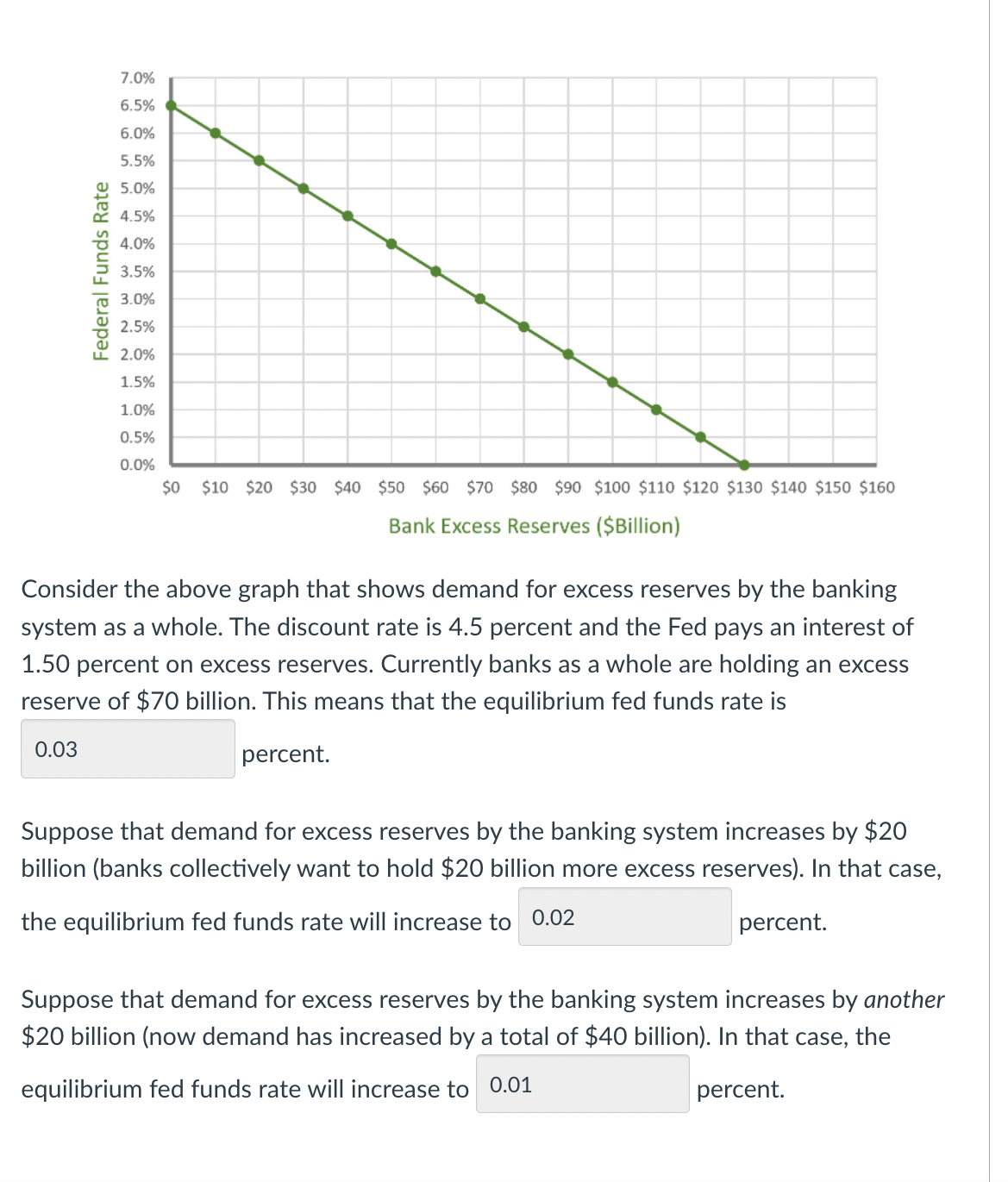Consider the above graph that shows demand for excess reserves by the banking system as a whole. The discount rate is 4.5 percent and the Fed pays an interest of 1.50 percent on excess reserves. Currently banks as a whole are holding an excess reserve of $70 billion. This means that the equilibrium fed funds rate is 0.03 percent. Suppose that demand for excess reserves by the banking system increases by $20 billion (banks collectively want to hold $20 billion more excess reserves). In that case the equilibrium fed funds rate will increase to 0.02 percent.
Consider the above graph that shows demand for excess reserves by the banking system as a whole. The discount rate is 4.5 percent and the Fed pays an interest of 1.50 percent on excess reserves. Currently banks as a whole are holding an excess reserve of $70 billion. This means that the equilibrium fed funds rate is 0.03 percent. Suppose that demand for excess reserves by the banking system increases by $20 billion (banks collectively want to hold $20 billion more excess reserves). In that case the equilibrium fed funds rate will increase to 0.02 percent.
Microeconomics A Contemporary Intro
10th Edition
ISBN:9781285635101
Author:MCEACHERN
Publisher:MCEACHERN
Chapter13: Capital, Interest, Entrepreneurship, And Corporate Finance
Section: Chapter Questions
Problem 13PAE
Related questions
Question

Transcribed Image Text:7.0%
6.5%
6.0%
5.5%
5.0%
4.5%
4.0%
3.5%
3.0%
2.5%
LL 2.0%
1.5%
1.0%
0.5%
0.0%
$0 $10 $20 $30 $40 $50 $60 $70 $80 $90 $100 $110 $120 $130 $140 $150 $160
Bank Excess Reserves ($Billion)
Consider the above graph that shows demand for excess reserves by the banking
system as a whole. The discount rate is 4.5 percent and the Fed pays an interest of
1.50 percent on excess reserves. Currently banks as a whole are holding an excess
reserve of $70 billion. This means that the equilibrium fed funds rate is
0.03
percent.
Suppose that demand for excess reserves by the banking system increases by $20
billion (banks collectively want to hold $20 billion more excess reserves). In that case,
the equilibrium fed funds rate will increase to 0.02
percent.
Suppose that demand for excess reserves by the banking system increases by another
$20 billion (now demand has increased by a total of $40 billion). In that case, the
equilibrium fed funds rate will increase to 0.01
percent.
Federal Funds Rate
Expert Solution
This question has been solved!
Explore an expertly crafted, step-by-step solution for a thorough understanding of key concepts.
This is a popular solution!
Trending now
This is a popular solution!
Step by step
Solved in 2 steps

Knowledge Booster
Learn more about
Need a deep-dive on the concept behind this application? Look no further. Learn more about this topic, economics and related others by exploring similar questions and additional content below.Recommended textbooks for you



Principles of Economics 2e
Economics
ISBN:
9781947172364
Author:
Steven A. Greenlaw; David Shapiro
Publisher:
OpenStax



Principles of Economics 2e
Economics
ISBN:
9781947172364
Author:
Steven A. Greenlaw; David Shapiro
Publisher:
OpenStax